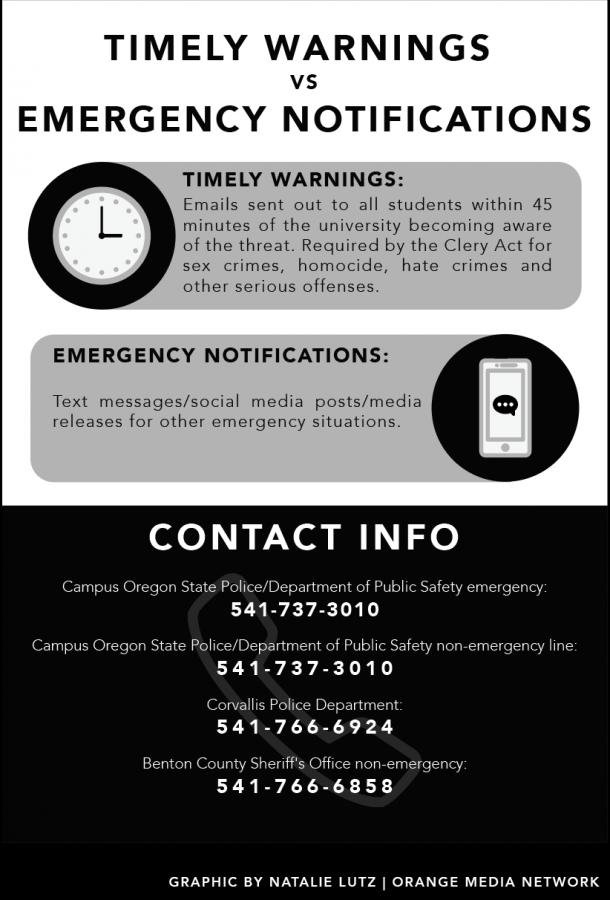Law enforcement encourages students to speak up about suspicious activity
March 12, 2018
University working to improve threat detection, timely warnings.
Some students saw the threats online. Others heard about them from friends. But when a former Oregon State University student threatened to shoot members of the OSU community on campus last week, the question from many students was, ‘Why didn’t the university tell us sooner?’
On Tuesday, Feb. 27, violent threats were made against the OSU community on Twitter. According to an all-students email, the university became aware of these posts at 12:02 p.m. and issued a warning on social media at 12:52 p.m. The next day, the individual responsible was arraigned on four charges spanning two separate cases, including first and second degree disorderly conduct as well as menacing.
Suzy Tannenbaum, the chief of public safety in the OSU Department of Public Safety, said the university is working to implement software systems and new procedures to expand monitoring of threats made on social media. These new systems are intended to identify threats more efficiently. Currently, a trained group of staff members from DPS and the Oregon State Police force evaluates and responds to reports of threats, crimes and other emergency situations on campus 24 hours a day.
“If there is an actual threat, this group acts to communicate to the university community with timely warnings and emergency notifications,” Tannenbaum said in an email. “We communicate with students, faculty, staff and, in some cases, families of students. We provide these communications to reach as many people as possible as immediately as possible. Yet, even then, we know that not everyone is taking note.”
According to OSP Lt. Eric Judah, a threat is more credible if the person making it has a history of threatening or violent behavior, and if they have the means, opportunity and intent to carry it out.
“Some do it to get attention and some to create terror and some for a bit of both,” Judah said in an email.
Regardless of how a threat is made, whether through social media or other means, when law enforcement becomes aware of it they will investigate, Judah said. The lieutenant advised students to report these sorts of behaviors immediately to assist public safety professionals in their efforts.
“In this case, the suspect was actively engaged in tweeting with others 12 to 10 hours before we were notified. That’s too long,” Judah said in an email. “Usually students are dismissive of these threats and will not report immediately.”
In an all-students email released after the suspect was arrested on Tuesday, Mike Green, OSU vice president of Finance and Administration and Steve Clark vice president of University Relations and Marketing also noted that despite the posts being active since early Tuesday morning, the university was not informed until just after noon.
“As a community, we all must recognize that such a delay is problematic,” the administrators said in the email.
Green noted these methods of communication have greatly expanded in the past several years, reaching more than 15,000 student families when necessary. OSU has also increased the number of university public safety staff and OSP troopers who patrol campus, as well as offered safety trainings for students, faculty and staff.
“We constantly evaluate and seek to improve our public safety systems and communications,” Green said in an email. “If there was an actual incident occurring, such as an active shooter, we have pre-planned systems in place for immediate notifications to the OSU community.”
If a threat or crime involving the OSU community falls under the Clery Act, the university strives to issue a timely warning email and text through our OSU Alert system within an hour of becoming aware of the threat, Tannenbaum said. Other matters, such as school closure or a non-Clery crime that may affect the campus, may also warrant an emergency notification which could be sent out through social media, as well as e-mail and text through our OSU Alert system. All students and employees are automatically signed up for e-mail alerts through OSU Alert. Everyone who has this OSU Alert account can also add cell phone numbers, as well as parents and significant others onto their notification account.
The federal Clery Act, which was passed after Lehigh University student Jeanne Clery was raped and murdered by a fellow student in her residence hall, requires colleges that receive federal financial aid make data about certain crimes available to current and prospective students. According to the Clery Center, a nonprofit founded by Clery’s parents, these institutions must issue timely warnings for sex crimes, homicide, hate crimes and other serious offenses.
Beyond the university itself, the Corvallis Police Department works to help students stay alert about issues of safety. CPD, DPS, OSP and other agencies communicate threats as each organization becomes aware of them. CPD Lt. Daniel Duncan said the university does a good job of informing the student body, and encouraged all students to be active participants in keeping themselves and the community safe.
“Be aware of what is going on around you, and do not be afraid to report suspicious activity,” Duncan said via email.
OSU’s public safety staff works with campus departments, federal and state agencies, students and faculty to determine the best way to inform the nearly 32,000 students on campus, Tannenbaum said.
“At Oregon State, our first priority is the safety of our community,” Tannenbaum said in an email. “We hope that our community understands that no emergency event, incident of crime or weather occurrence is the same. With that in mind, we do our best to provide for the safety of our campuses.”
























































































































